Modelos operativos
En el informe del Estado Global de los Programas de Transferencias Monetarias de la CALP Network se identifican diferentes tipos de modelos operativos, incluyendo consorcios y alianzas, mecanismos de entrega de efectivo compartidos, entrega de efectivo a través de un único organismo, y la integración de sistemas.
“La estructura general a través de la cual los organismos trabajan conjuntamente… para llevar a cabo programas de transferencias monetarias… en la respuesta y el análisis de situaciones, en el diseño de programas y en su implementación”
Definición de trabajo de la CALP Network sobre un modelo operativo.
La ampliación de los PTM ofrece oportunidades para transformar la forma en que se entrega la ayuda humanitaria. Tiene implicaciones en el papel que desempeñan diferentes agencias dentro de diversos modelos operativos, y la posibilidad de vincular los modelos a los sistemas de protección social. También influirá en la naturaleza de las asociaciones con proveedores de tecnología y servicios financieros, y cómo los diferentes modelos interactúan con otras formas de asistencia, más allá del efectivo.
Prioridades actuales
Desde finales de 2016, la CALP Network ha coordinado un programa de aprendizaje para ayudar a responder las siguientes preguntas:
- ¿Qué modelos operativos están a disposición de las agencias encargadas de implementar los PTM?
- ¿Cómo mejoran los diferentes modelos la eficiencia, la eficacia y la rendición de cuentas de los PTM en diferentes contextos?
- ¿Qué modelos operativos son más apropiados y en qué contextos?
La CALP Network seguirá cotejando y difundiendo la base de evidencias para los modelos operativos.
La CALP Network es también un socio del consorcio Cash Monitoring, Evaluation, Accountability, and Learning Organizational Network (CAMEALEON), liderado por el Consejo Noruego para los Refugiados, que es responsable del monitoreo y evaluación independiente de las transferencias monetarias multipropósito (TMM) del Programa Mundial de Alimentos (PMA) en el Líbano. Esto incluye la investigación y análisis acerca del valor por dinero y la rendición de cuentas en el modelo operativo.
Contenido destacado

Operational Models: Accountability to affected people
Webinar

MEAL in Emerging Operational Models
Webinar

CTP Operational Models Analytical Framework
Guidelines and Tools
The State of the World’s Cash Report launched by the CALP Network in February 2018 highlights trends in the uptake of various operational models for the delivery of cash at scale in humanitarian response. Current decision making on the choice between these various operational models is highly influenced by context, and by the policies and approaches of donor agencies. Decision making on...
Últimos recursos

Examining Differences in the Effectiveness and Impacts of Vouchers and Unconditional Cash Transfers
Report
The objective of this study is to examine the differences in the effectiveness and impacts of vouchers versus unconditional cash transfers in the Bushani camp of the Masisi territory of the Democratic Republic of Congo. As part of this research, the study team collected household data from over...
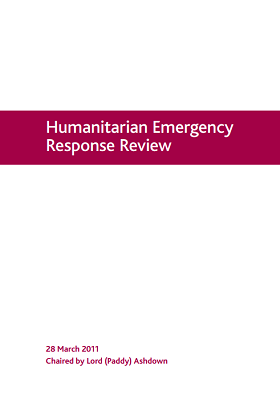
Humanitarian Emergency Response Review
Report
This independent review into how the UK (through DFID) responds to humanitarian emergencies, considers how the UK should best respond to overseas emergencies and the role the UK should play in the international humanitarian system. It looks at the potential future humanitarian challenges and the...
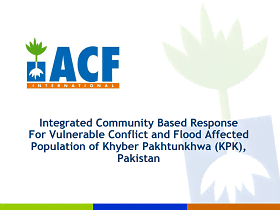
Integrated Community Based Response for Vulnerable Conflict and Flood Affected Population of Khyber Pakhtunkhwa (KPK), Pakistan
Presentation
A presentation discussing objectives, modalities, target beneficiaries and best practices of integrated community-based response for vulnerable conflict and flood-affected population of Khyber Pakhtunkhwa (KPK), Pakistan.
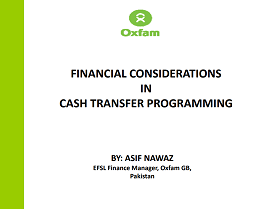
Financial Considerations in Cash Transfer Programming
Presentation
OBJECTIVES OF THE PRESENTATION • Finance considerations and challenges in CTP • Delivery Mechanisms used in the Flood Response. • Oxfam’s Experience with Order Cheques – Challenges and Innovation. • Delivery Mechanism’s – the selection dilemma.

Oxfam Programme Quality Standards: Cash transfer programmes (CTPs)
Guidelines and Tools
Through its Emergency Food Security and Vulnerable Livelihoods (EFSVL) work, Oxfam aims to meet immediate food needs and protect livelihoods, whilst contributing to the longer term economic recovery of disaster affected populations and increasing their resilience to future shocks. Oxfam believes that...
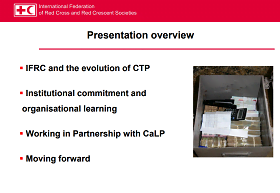
IFRC and the evolution of CTP
Presentation
An IFRC presentation covering the following topics: IFRC and the evolution of CTP Institutional commitment and organisational learning Working in Partnership with the CALP Network Moving forward
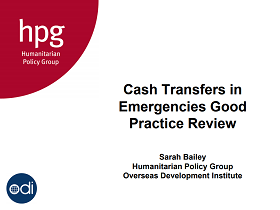
Cash Transfers in Emergencies Good Practice Review: Presentation
Presentation
Powerpoint presentation on the then-forthcoming Good Practice Review on cash transfer programming in emergencies.
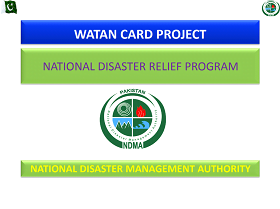
Watan Card Project – Pakistan National Disaster Relief Program
Presentation
Presentation to the CALP Network 4th Global Learning Event (Bangkok, February 2011) from the National Disaster Management Authority of the Government of Pakistan. The presentation reviews the WATAN card cash transfer programme implemented by the Government to transfer money to flood affected people. The...

Delivering money: Cash transfer mechanisms in emergencies
Report
This report documents lessons learned in cash transfer programming in emergencies, with a particular focus on the practicalities of how to deliver money to beneficiaries. It provides guidance for project managers needing to make choices about how to efficiently and effectively deliver cash, and explores...

Minimum Economic Recovery Standards
Guidelines and Tools
The Minimum Economic Recovery Standards articulate the minimum level of technical and other assistance to be provided in promoting the recovery of economies and livelihoods affected by crisis.
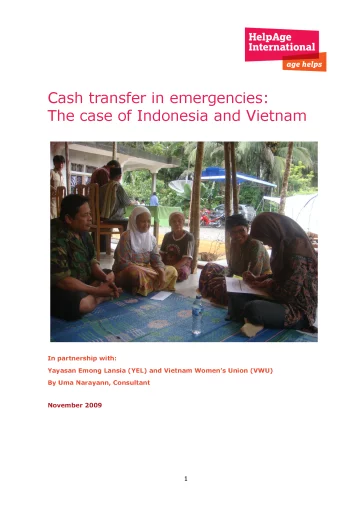
Cash Transfers in Emergencies: The case of Indonesia and Vietnam
Case Study
In October 2009, typhoon Ketsana brought heavy rains over Vietnam causing sudden and heavy flooding, which led to considerable loss of lives, shelters and livelihoods. Around the same time, an earthquake measuring 7.2 on the Richter scale struck the island of Sumatra in Indonesia causing massive loss of...
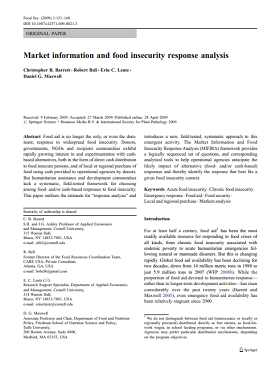
Market Information and Food Insecurity Response Analysis (MIFIRA)
Report
This paper outlines the importance and rationale for agencies to undertake a “response analysis” before choosing an appropriate programme delivery mechanism to a humanitarian situation. The Market Information and Food Insecurity Response Analysis (MIFIRA) framework is introduced. This provides a...
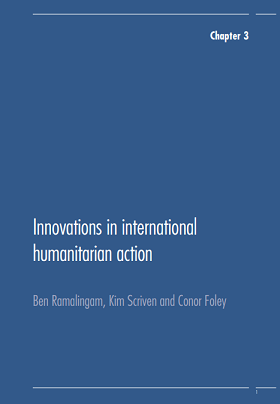
Innovations in International Humanitarian Action
Report
This document forms the third chapter of ALNAP’s 8th Review of Humanitarian Action, for more information and access to other chapters, please click here. Critics of humanitarian aid, many from within the sector, complain that humanitarian evaluations and other learning exercises repeatedly highlight...
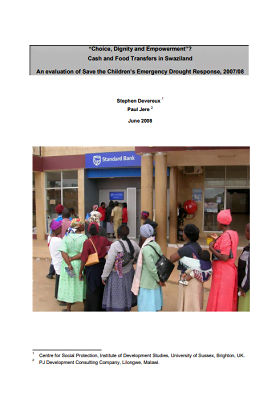
Choice, dignity and empowerment? Cash and food transfers in Swaziland: An evaluation of Save the Children’s emergency drought response
Case Study
This evaluation report looks at the Save the Children’s cash transfer project, which was a response to the 2007/8 food crisis in Swaziland, with the aim of not only providing humanitarian assistance but also as a way to break the dependency of rural families on food aid. Selected beneficiaries were...

A summary of the British Red Cross cash grants for livelihood recovery in Aceh, Indonesia
Case Study
From April 2005 to June 2008, the British Red Cross Society (BRCS) disbursed more than USD 10 million in cash grants directly to over 10,000 tsunami-affected people in Aceh to support the recovery of their predominantly agriculture and fisheries-based livelihoods. This study draws lessons from the rich...

Case Study of the Poultry and Grape/Raisin subsectors in Afghanistan: Guided case study in value chain development for conflict-affected environments
Report
Is the value chain approach effective for restoring market-based economic activity in a severely affected post-conflict environment?. The goal of this study is to gather empirical evidence to answer this question, looking at the role of the value chain approach in the work of USAID’s Rebuilding...

Practitioners’ Guide to the Household Economy Approach
Guidelines and Tools
This guide is aimed at those carrying out household economy approach (HEA) assessments, and is intended to serve as both a refresher guide for experienced practitioners and a set of reference reading materials to accompany formal trainings for new practitioners. The Practitioners’ Guide is presented as...

Implementing cash-based interventions: A guideline for aid workers
Guidelines and Tools
This is a comprehensive guide to the theory and practice of cash-based interventions in the field, covering cash grants, vouchers, and labour-based interventions (cash for work). It also includes practical templates including examples of questionnaires, market surveys, beneficiary cards, voucher formats...
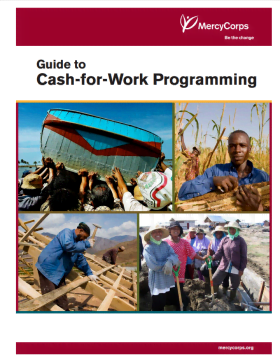
Guide to Cash-for-Work Programming
Guidelines and Tools
Cash-for-Work is a short-term intervention used by humanitarian assistance organizations to provide temporary employment in public projects (such as repairing roads, clearing debris or re-building infrastructure) to the most vulnerable segments of a population. The methodology is relatively new, but its...


